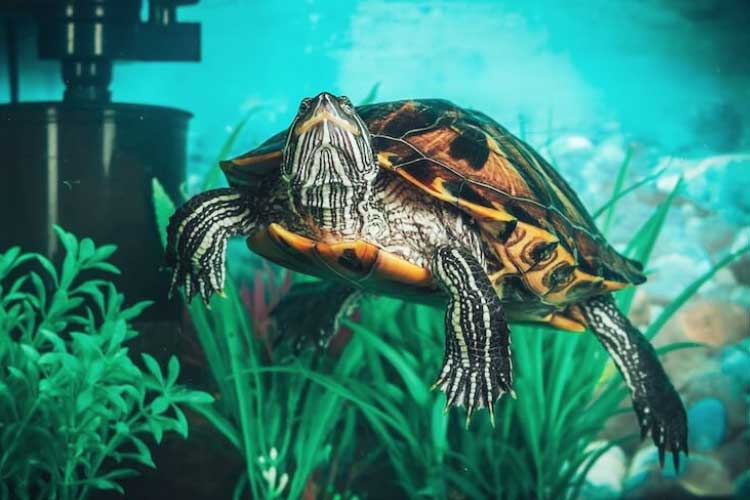Plants For Red-Eared Slider Tank
If you’re planning your red-eared slider tank setup and want it to look good and have a naturalistic feel, then live plants would be one of the items to consider. However, not all plants are safe for your slider turtle tank. So, which live plants should you put in your red-eared slider tank?
Plants for the red-eared slider tank should be non-toxic and safe for your pet turtle and include water hyacinth, Amazon sword, common waterweed, duckweed, hornwort, moneywort, java fern, dwarf hair grass, java moss, anubias, anacharis, hornwort, among others.
This article covers more details about what plants you should consider for your red-eared slider tank. You’ll discover whether your turtle pet can live with plants in its enclosure, which plants are a favorite for them, whether your turtle tank requires live plants, and more.
Plants for red-eared slider tank
Contents
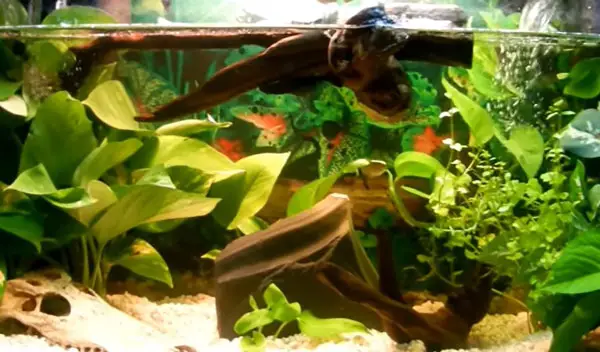
There are plenty of plants you can put in your red-eared slider turtle tank. You just need to ensure that the plant you use is non-toxic and will not bring any harm to your pet if it eats it.
Below, we outline the full list of the best plants for a red-eared slider tank:
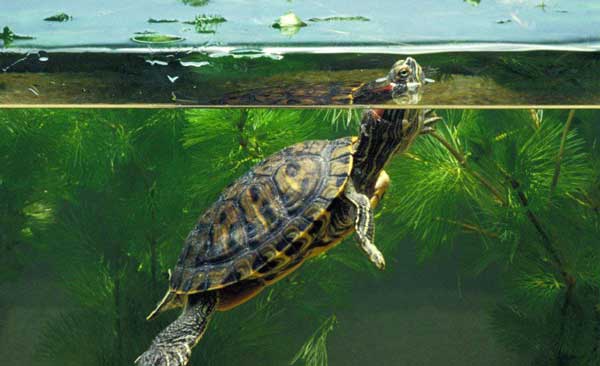
- Amazon sword: This is one of the best aquatic plants to consider for turtle tanks. it’s pretty easy to grow and doesn’t demand a lot of maintenance. Sometimes your red-eared sliders may eat this plant, but not the whole of it. They may also uproot it from the substrate when in the mood.
- Water hyacinth: This plant sprouts purple flowers that help beautify your turtle tank. But more importantly, it helps absorb excess nutrients in your turtle enclosure, helping keep the tank clean.
- Common waterweed: The waterweed is inexpensive, easy to grow, and requires no maintenance, making it one of the best plants for your slider turtle’s enclosure. However, note that your pet turtle may feed on this plant and it contains plenty of nutrition for turtles.
- Duckweed: As its name suggests, this plant is essentially a weed, meaning it won’t require a lot of effort to make it thrive in your turtle tank. The plant is a good choice because it’s capable of absorbing ammonia and nitrites in the water to help keep your tank clean. Plus, it’s nutritious for your turtle, and safe for them to eat.
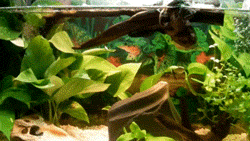
- Hornwort: The hornwort is a good choice of red-eared slider aquatic plant if you’re looking for a plant your pet turtle won’t eat. It’s not harmful to your turtle, but your pet may not like its taste. Keep in mind that this plant requires no substrate or a lot of maintenance. It also does well in various conditions.
- Java fern: This is another inexpensive, easy-to-care-for, and maintain aquatic plant to consider for your turtle tank. However, the tree easily comes off the substrate and floats on the tank surface, so you’ll need to tie it down to something. Your turtle may also try to eat this plant.
- Dwarf Water lettuce: This is a fast-growing aquatic plant that requires medium light, but it can also thrive in low light. This plant can grow pretty fast if your tank water flow is poor and it can develop long roots that hit all the way to the bottom of your tank.
- Anubias: The Anubias plant is also turtle-tank-friendly and pretty easy to maintain. It needs to be plucked, to the tank substrate to keep it from floating around. This plant may take a while longer to grow but once it does, it sprouts large, beautiful leaves that help beautify your turtle tank!
- Java moss: This low-maintenance plant will also do quite well in your turtle aquarium. its dense root system provides good filtration to help absorb plenty of waste present in your aquarium. Since this plant grows quite fast, you won’t have to worry if your turtle eats it.
Other plants to consider for your red-eared slider turtle tank include the Anacharis, moneywort, dwarf hair grass, etc.
What are the best floating plants for a red-eared slider tank?
Some of the plants we’ve discussed in our previous section are essentially floating plants for red-eared slider tank and include duckweed, water hyacinth, duckweed, and water lettuce.
Additional floating plants to consider include Frogbit and Salvinia. Frogbit, in particular, is popular due to its nicely rounded leaves and its similar looks to water lily that helps liven up your turtle tank.
Also, it grows pretty fast (it can produce two leaves every 2 days) and can be quite invasive to your tank or pond. It is quite hardy and requires little maintenance.
Floating plants generally don’t require any substrate to thrive in your turtle tank. They also control algae growth by limiting the amount of light entering the tank.
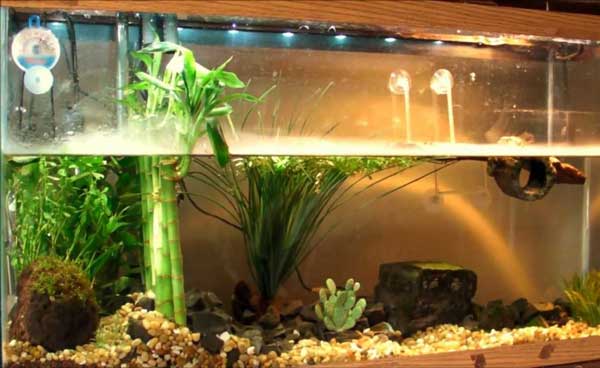
Since their roots grow into the water, they do an even better job at absorbing the tank wastes.
However, keep in mind that these plants will take up a lot of space if you put too many of them in your turtle tank. They may end up taking the entire surface, leaving your slider with little to no swimming space.
To avoid this, make sure you only throw a few plants inside that help keep the water clean and provide shade or hiding spots for your turtle.
Whatever plant you choose, make sure it’s safe for your turtle and will not harm its health once it ingests it.
Which plants are toxic to red-eared slider turtles?
Toxic plants that you should NEVER put in your red-eared slider’s turtle tank include water hemlock, ivy, and milkweed.
If your turtle accidentally ingests any of these plants, it can develop health complications and even die!
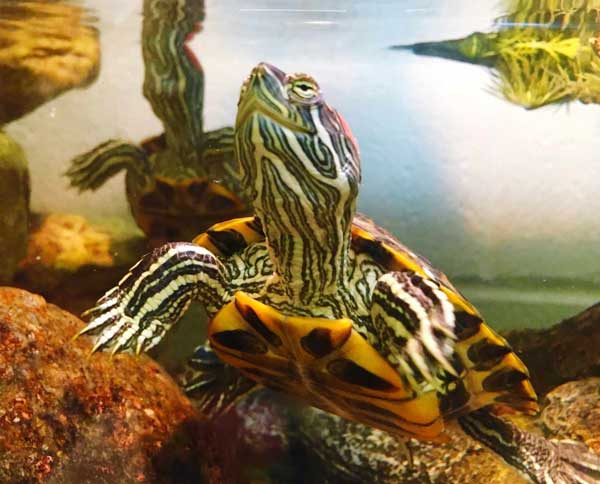
Still at it, you should avoid all pants that require too much oxygen and light. This is especially true for aquatic plants that go underwater.
Plants with weak root systems should also be avoided as they can float easily and take up your pet’s swimming space.
What plant can red-eared sliders eat?
Red-eared sliders eat a variety of aquatic plants including the floating Azolla (fairy moss), waterweed, duckweed, frogbit, water hyacinth, hornwort, anacharis, java fern, amazon sword, and water lettuce.
Generally, the sliders like to eat anything green, but they have their favorite plants that we’ve just listed here.
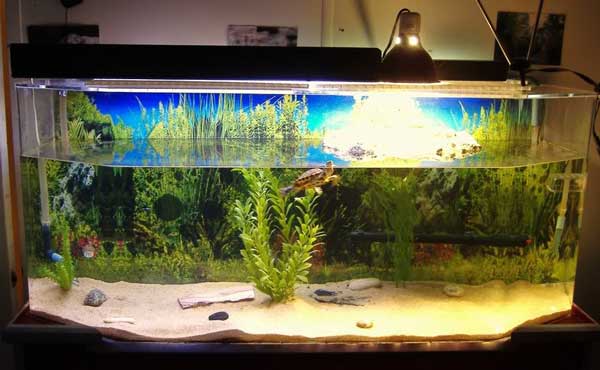
The good is that all these plants are completely safe for your turtle if they ingest them, and they may even carry some nutrition that helps with the turtle’s healthy body.
Remember, red-eared sliders are omnivores and require plant materials as part of their diet.
Do red-eared sliders need plants in their tank?
Red-eared sliders don’t necessarily require plants in their enclosures. However, providing them with plants can have a lot of benefits to their habitat and improve their overall living conditions.
To start with, live plants help decorate your turtle tank and make it more aesthetically appealing and even exciting to your pet turtle as they create a naturalistic environment that makes them feel at home.
It also provides your turtle with plenty of hiding spots, so your pet feels less stressed Your red-eared sliders, being omnivores, may also eat these plants from time to time, explore and hide in them.
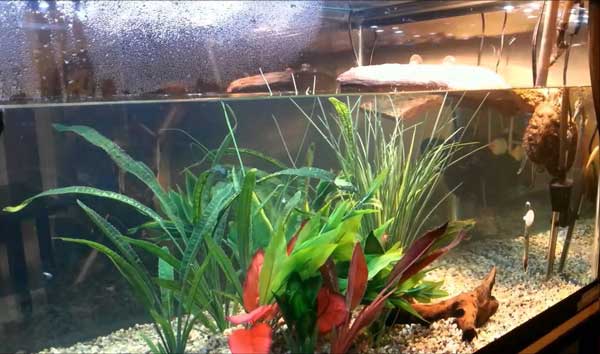
Live plants will also help oxygenate the water which is healthy for your turtle the more plants you have, the more oxygen content your water gets. This is especially helpful if you also have fish in your turtle tank.
With live plants, dangerous ammonia and nitrates will also be filtered from the water.
Moreover, introducing live plants in your turtle tank will help reduce bacteria and algae growth, thus improving your turtle tank’s water quality.
FAQs:
Red-eared sliders’ natural habitat in the wild has natural plants which they feed on and use as hiding spots, so there’s no reason your captive RES won’t live with plants in its aquarium.
While fake pants also help decorate your turtle tank, we advise against using the. The fact that your red-eared slider will eat live plants also means they’ll attempt to eat fake plants you throw in their tank. This can cause serious digestive issues for your pet turtle.
If your turtle dugs them up, they can make your tank dirty and make cleaning harder for you. Turtles may end up eating them. The plants also require maintenance. And some aquatic plants are toxic for your slider if it ingests them.
Final Verdict
There are many safe plants that you can put in your red-eared slider turtle tank and won’t harm them if they ingest them. Some of the best plants for a red-eared slider tank include common weed, duckweed, water hyacinth amazon sword, frogbit, java moss, Anubias, and hornwort, among others. However, there are poisonous plants to avoid such as ivy, milkweed, and water hemlock.
Remember, live plants have plenty of benefits for your pet turtle’s tank other than making the living environment eye-pleasing and naturalistic for your turtle. They help absorb excess waste to keep your tank clean, oxygenate your turtle tank, control algae growth, and create plenty of hiding spots. Which of the above turtle-safe plants would you consider for your turtle tank?


